It seems that NVIDIA is quite set on making sure it secures a fair chunk of the mobile market, so it will focus much of its resources on the Tegra family of SoC, even multi-core models according to a recent document.
Though Intel may have managed to drive NVIDIA out of the x86 chipset business, the Santa Clara, California-based GPU maker has another business outlet to see to.
Said outlet is that of mobile platforms for tablets and smartphones, SoCs as it were (system-on-chip devices), the most recent, and best known so far, being the Tegra 2.
The Tegra family of mobile platforms is based on the ARM architecture and, though it has yet to make a lasting impact on the market, may soon truly shine.
So far, the Tegra 2 has shown up in several tablets and smartphones, but it is its multi-core successor that is set to make a bigger difference.
According to a whitepaper that NVIDIA recently published, there are dual-core versions of the product on the way.
The company claims that it will easily outdo all processors based on the ARM architecture that exist right now.
NVIDIA also says that, while the processor will have more transistors, it will deliver equal or superior performance to single-cores at lower clocks and voltages.
What this means is that dual-core designs will actually be more efficient (will use less power) than single-core ones, of up to 40% to be exact, at least in certain usage scenarios.
The whitepaper seems to deal very much with gaming performance, and Tegra 2 is said to be about 2.5 times faster with both cores enabled or 45% better with just a single core in use. Those interested can read it here.
What remains to be seen is just how much better than this the Tegra 3 ends up being once it inevitably gets put together.

 14 DAY TRIAL //
14 DAY TRIAL //